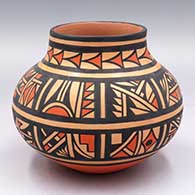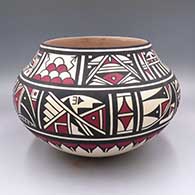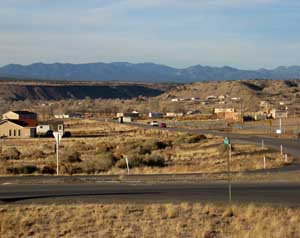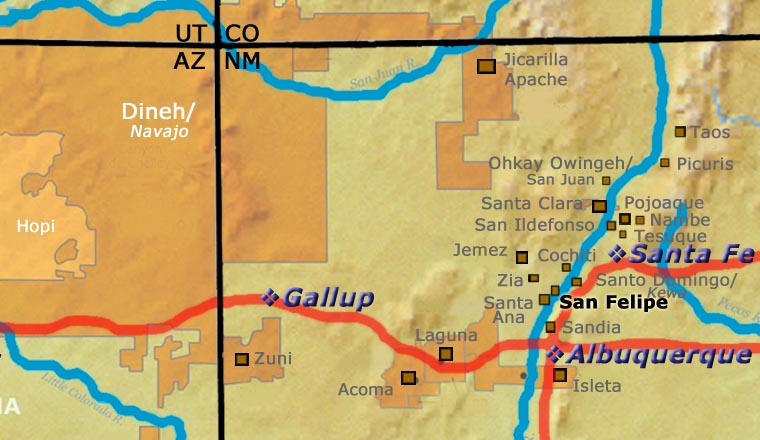
Click or tap to see a larger version
Joseph Latoma, San Felipe, Black-on-white jar with 3 bands of Zuni geometric designs
San Felipe
$ 1500
ahsf2e148
Black-on-white jar with 3 bands of Zuni geometric designs
13.25 in L by 13.25 in W by 7.75 in H
Condition: Good with some areas overpainted by the artist and some flaking on the bottom, priced according
Signature: Joseph and Nona Latoma San Felipe Zuni N.M.
Sale Price: $1150
Tell me more! Buy this piece!
(505) 986-1234 - www.andreafisherpottery.com - All Rights Reserved
Joseph Latoma
San Felipe

Joseph Latoma was born into San Felipe Pueblo in May 1966. He is the son of Margaret Chavez of San Felipe and Joe Latoma of Zuni. He was exposed to a lot of silversmithing as he grew up and he still does that. Joseph indicated to Dr. Greg Schaaf that he learned to make pottery from his great-grandfather. Later he said he learned through eight years of trial and error.
Joseph likes to make traditional artifacts, tools and jars. Some of his jars are more than 12 inches high and more than 15 inches in diameter.
There is little documented pre-contact San Felipe pottery so Joseph had to develop his own style. He based his designs on the memories of San Felipe and Zuni elders.
Nona Latoma
San Felipe
Nona Latoma is the wife of San Felipe Pueblo potter Joseph Latoma. Joseph is a self-taught potter, and Nona learned right along with him. Joseph made a few pots on his own but most he's made in collaboration with Nona.
Other than her and Joseph teaching all their children how to make pottery the traditional way, there's not much mention of Nona anywhere.
San Felipe Pueblo

San Felipe Pueblo today
During the great migrations of the 13th century from the Four Corners area to the valley of the Rio Grande, the people of Cochiti, Santo Domingo and San Felipe were one tribe, carrying with them the heart of what we now know as the Eastern Keres culture and religion. Archaeologists feel they mostly traveled from the Four Corners area around the north side of the Gallinas Highlands and the Jemez Mountains, staying south of the simultaneous Tewa migration happening in the Chama and Ojo Caliente River valleys. On arriving near the Rio Grande they settled in Frijole Canyon, on the southeastern side of the Pajarito Plateau. In the area now known as Bandelier National Monument, they built the village of Tyuonyi, and dug many residences into the soft volcanic tufa walls of the canyon. However, over time the Pajarito Plateau got too dry, too, and the people decided to move downstream into the valley of the larger Rio Grande. Once at the Rio Grande, they decided to keep moving south as the east bank was occupied by the Tewa and Tanoan people. Disagreements among the Keres over where to settle split the people into what is now the Cochiti, Santo Domingo and San Felipe tribes.
When Francisco de Coronado arrived in 1540, there were several Tiwa pueblos in the Middle Rio Grande area. He and his men attacked them all, stealing whatever food they could and inadvertently making sure all the natives were exposed to European diseases. When the Spanish came back in 1598, the Tiwa had been reduced from fifteen villages to two: Isleta and Alameda (now Sandia), and both were off to the south. Instead, there were now two Keres-speaking villages, one on either side of the Rio Grande, in the valley directly north of the ruined pueblo at Kuaua (today's Bernalillo). The main Keresan villages were comprised of large two-and-three-story structures plus a couple hundred outlying dwellings. The Spanish Franciscan monks forced the San Felipes to build their first mission church on top of their main kiva, next to the east village, around 1600.

Part of the San Felipe ancestral home
The people of San Felipe participated in the Pueblo Revolt of 1680 but killed no Spaniards nor any priests. Governor Otermin returned with troops in 1681 and found San Felipe abandoned as the people had hidden themselves atop nearby Horn Mesa. The Spaniards looted and burned the pueblo before returning to Mexico. When Don Diego de Vargas came back in 1692, the people chose to surrender and be baptised rather than flee or fight. To test the peace they first settled atop nearby Santa Ana Mesa. A few years later they descended into the Rio Grande Valley and built the beginnings of today's pueblo.
San Felipe has always had more arable land than most of the other pueblos and is still known for its agricultural products, although in modern times, most residents commute off-pueblo to work. The long-held isolationism of the San Felipe people has contributed to the loss of many traditional activities, including the making of pottery. Most San Felipe potters active today either learned the art on their own or learned from artisans at other pueblos. The revival of San Felipe pottery tradition is further complicated by the fact so few people remember where good clay might be found on the pueblo lands.

Pueblos of the Rio Grande, Daniel Gibson, ISBN-13:978-1-887896-26-9, Rio Nuevo Publishers, 2001
Copyright © 1998-2025 by




